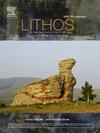Fluid infiltration along reactive porosity networks at the subduction interface: Evidence from the eclogite-facies Erro-Tobbio Unit (Ligurian Alps)
IF 2.9
2区 地球科学
Q2 GEOCHEMISTRY & GEOPHYSICS
引用次数: 0
Abstract
In subduction zones, seismicity and rock rheology are strongly influenced by the presence of fluids. However, the mechanisms governing fluid extraction and transport along the subduction interface are still debated. The meta-peridotite of the Erro-Tobbio Unit (Ligurian Alps) records fluid-rock interaction and associated deformation that occurred at intermediate subduction depths. Fluid pathways are represented by reaction bands of metamorphic olivine (Ol2) and Ti-clinohumite, formed by the breakdown of brucite (Brc) and antigorite (Atg) at 1.8–2.5 GPa and 500–650 °C. Field and microstructural analyses allowed the role of deformation in the development of ORBs to be assessed. In-situ determination of trace elements by LA-ICP-MS allowed the scale of fluid circulation along reaction-induced channels to be constrained.
The reaction bands occur within both meta-peridotite cores and wrapping horizons of prograde antigorite mylonites. The meta-peridotite shows two main sets of reaction bands: Set1, oriented at high angle to the bounding mylonites, and Set2, trending N-S, parallel to the mylonites (where only Set2 is present). A decrease in spacing between reaction bands of Set2 highlights a strain gradient from the undeformed meta-peridotite cores to the mylonites. This gradient, associated with oriented growth of Ol2 in the mylonites, suggests that the reaction bands developed during mylonitization. Brc relics mostly localized within the reaction bands indicate that formation of Ol2 was originally controlled by the Brc distribution. Such channel networks have been described in previous works as the result of channel-forming reactive porosity related to initial breakdown of thermodynamically favoured domains. The formation of the reaction bands may be therefore related to formation of low-Si fluids in Brc-rich areas, which triggered Atg breakdown and formation of porosity by flowing along planes consistent with the stress field.
Later stage, Al-free serpentine (Atg + chrysotile/lizardite) locally replaces Ol2 along a pervasive network of microcracks exploiting the reactive sites of Set1-Set2 structures. An enrichment in fluid-mobile elements (As, Sb, Ba, W, Li, B) in prograde Ol2 and later-stage Al-free serpentine provides evidence of two stages of infiltration of slab-derived fluids, indicating open-system conditions during eclogite-facies deformation and during retrogression. We speculate that the Erro-Tobbio Unit was subducted at an early stage of Adria-Europe convergence and settled atop the interface within the deep slow-earthquakes depth range, above the continuously under-riding and dehydrating Alpine slab. In this environment, the Erro-Tobbio Unit was affected by intense chemical exchange due to fluid fluxing from the underlying subducting units.
求助全文
约1分钟内获得全文
求助全文
来源期刊

Lithos
地学-地球化学与地球物理
CiteScore
6.80
自引率
11.40%
发文量
286
审稿时长
3.5 months
期刊介绍:
Lithos publishes original research papers on the petrology, geochemistry and petrogenesis of igneous and metamorphic rocks. Papers on mineralogy/mineral physics related to petrology and petrogenetic problems are also welcomed.
 求助内容:
求助内容: 应助结果提醒方式:
应助结果提醒方式:


